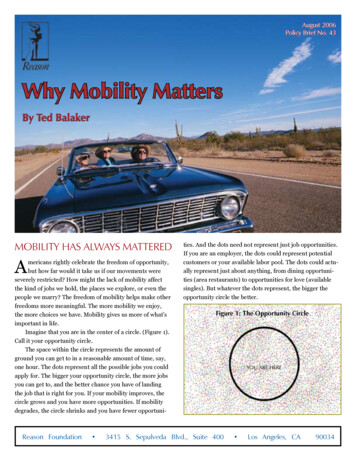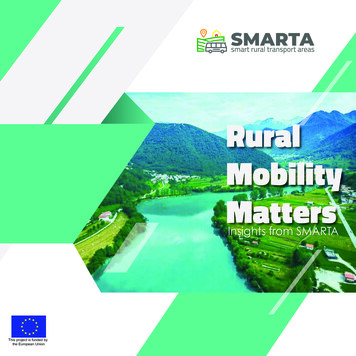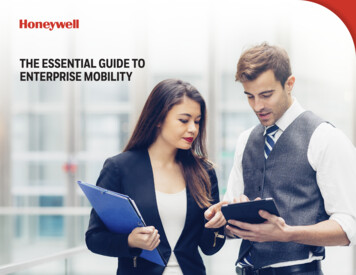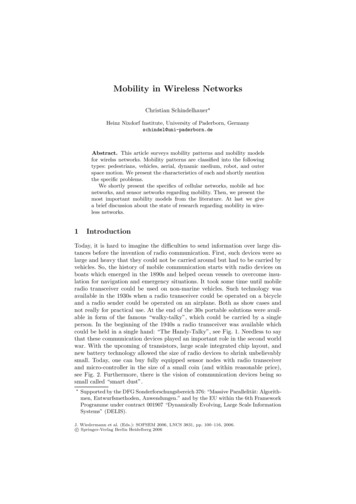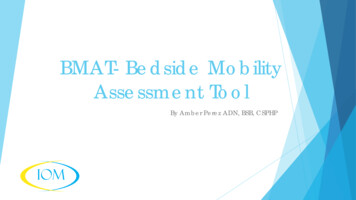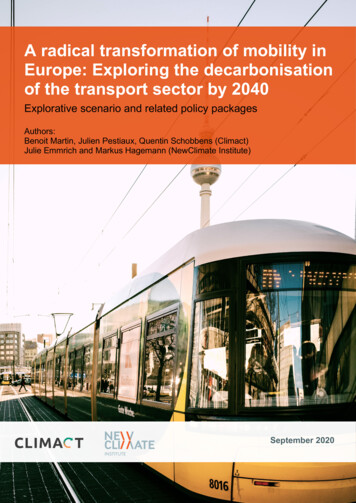
Transcription
A radical transformation of mobility inEurope: Exploring the decarbonisationof the transport sector by 2040Explorative scenario and related policy packagesAuthors:Benoit Martin, Julien Pestiaux, Quentin Schobbens (Climact)Julie Emmrich and Markus Hagemann (NewClimate Institute)September 2020
A radical transformation ofmobility in Europe: Exploring thedecarbonisation of the transportsector by 2040Explorative scenario and related policy packagesProject number819028 NewClimate Institute 2020 Climact 2020AuthorsBenoit Martin, Julien Pestiaux, Quentin Schobbens (Climact)Julie Emmrich and Markus Hagemann (NewClimate Institute)DisclaimerThe views and assumptions expressed in this report represent the views of the authorsand not necessarily those of the client.Commissioned by GreenpeaceCover picture: Photo by Julia Joppien on UnsplashDownload the limact.com/en/news-publications
A radical transformation of mobility in Europe: Exploring the decarbonisation of the transport sector by 2040Executive summaryPotential threats linked to climate change compel us to drastically reduce greenhouse gas (GHG)emissions. To even have a chance of limiting the global temperature rise to 1.5 C requires that globalemissions reach net-zero as soon as possible. The EU can play a leading role in this transition withambitious targets and policies. The transport sector accounted for 27% of EU emissions in 2017and is the only sector that has seen emissions increase since 1990. Reversing this trend is as essentialas it is complex. The hurdles for changes lie in the scale of the societal, technological and economicshifts needed: our mobility accounts for 26% of total EU energy consumption, using a fleet of 260million cars that are primarily powered by oil. (EEA, 2019)This study explores a future in which the EU effectively targets zero emissions by 2040 for thetransport sector without relying on biofuels (further information on the position on biofuels in footnote8). This explicit objective would enable a transition consistent with the magnitude and speed prescribedby the scientific community. It examines the intermediary targets required; it highlights and discussessome of the key economic risks, challenges and benefits associated with these profound efforts (e.g.the yearly production of cars); it recommends a set of policy packages that need to be implemented.The global Covid-19 pandemic has brought with it widespread disruption including a drastic drop inmobility demand as well as global behavioural changes such as remote working that were notconceivable before. Due to its scale and impact, the pandemic is a key moment for society to reflect onits priorities and an unprecedented opportunity to consider the future of certain sectors, includingtransport. It is not the aim here to contribute to the recent – albeit speculative – body of literature on theimpact of Covid-19. While we acknowledge the fact that Covid-19 will have an impact on transportdemand, this work primarily aims to highlight a pathway and policy options that exist to reach fulldecarbonisation by 2040.Figure 1:Yearly emissions - DT-2040 scenario (million tonnes of CO2).Climact / NewClimate Institute September 2020i
A radical transformation of mobility in Europe: Exploring the decarbonisation of the transport sector by 2040The scenario detailed in this study (“DT-2040”, short for “Decarbonisation of European Transport by2040”) highlights the fact that if the EU hopes to complete decarbonisation of the transport sector by2040, concerted and ambitious policy actions are required in all areas (see Figure 1). While supply-sidemeasures are undeniably essential to reducing emissions, this study illustrates how demand-sidemeasures such as demand reduction and a modal shift facilitate the transition by reducing the scale ofdeployment of new technologies to challenging but plausible levels. To date, policies to improve thevehicle fleet, such as emission standards and electric vehicle incentives and policies, have been at thecore of European and Member State policy developments, with mixed impact on the transport sector.However, the scenario shows that to improve the technical feasibility of the transition, passengervehicles not only need to shift to lower-emission alternatives, but transport demand and private vehicleuse also need to be reduced significantly. The decarbonisation scenario assumes a reduction in totalpassenger transport demand of -12% as well as a -33% reduction specifically for air transport, both by2040 (versus 2020 – the box below gives more explanation on taking 2020 as benchmark year). Privatevehicle use is assumed to decrease to an average mode share of 43% in urban areas by 2040 (from62% in 2015), with some urban centres going much below this figure, and 68% in rural areas (from 79%in 2015) by 2040. Hence efforts to reduce transport demand and shift to sustainable transport modesbeyond current good practice will be crucial to achieving full decarbonisation by 2040.In order for the supply side to contribute at the scale needed, current efforts also need to be scaled upquickly. Supporting innovation and enabling the massive deployment of new technologies will be key toachieving zero emissions. The shift to electric mobility must be accelerated: DT-2040 describes a futurein which all new light-duty vehicles (LDVs) sold by 2028 are zero emission. This means emissionstandards need to be on a path to reach zero emissions by 2028, or policies with a similar effect needto be implemented, effectively ending the sales of new internal combustion engines. Concerted policypackages, such as those currently found in Norway, need to be implemented across the board inMember States to accelerate the uptake of electric vehicles. Policy makers and car manufacturers needto collaborate closely to ensure this can be done with as little friction as possible, without losing theambition levels required.But even these ambitious measures will not be sufficient to achieve a zero-emission fleet by 2040: the“natural” renewal rate still results in a fleet composed of 39 million internal combustion engine (ICE)LDVs in 2040 (or 28% of the remaining fleet of 137 million passenger vehicles, which is down almost 50% compared with 260 million in 2015). To achieve decarbonisation by 2040 without biofuels, thesecars would need to be powered by synthetic hydrocarbons, or banned entirely. However, synthetichydrocarbons are not considered for road transport in the DT-2040 scenario, but only for modes wherealternatives do not seem feasible, such as aviation. Indeed, our analysis shows that the volume ofsynthetic hydrocarbons needed for the remaining ICE LDVs requires unrealistic levels of electricityproduction. This is mainly due to the very low efficiency of producing these fuels. Therefore, synthetichydrocarbons based on zero-emission electricity are one piece of the puzzle, but must always beconsidered as a last resort. And many other concerns remain in addition to low efficiency: theirdevelopment is still in its infancy, they would need to rely on direct air capture to be fully decarbonised,and their deployment only makes sense if the electricity itself is clean, which would require massivedeployments of zero emission electricity capacity. Therefore, a ban on the use of all ICE passengervehicles by 2040 is considered the only plausible option to decarbonise road transport. Such a bancould be progressive, and requires support for alternative modes of transport and the uptake of electricvehicles, with cities able to play a pioneering role by imposing bans earlier. The box below highlightssome of the key assumptions and technical results of the DT-2040 scenario.On the demand side, policies to avoid and reduce the need for transport and to shift to moreenvironmentally friendly transport modes have received much less attention, and lack coordination atEU level. Lower passenger transport demand is key since this will directly reduce the technologicalefforts required, both for direct and indirect electricity demand as well as for e-fuels in air transport. TheClimact / NewClimate Institute September 2020ii
A radical transformation of mobility in Europe: Exploring the decarbonisation of the transport sector by 2040efficiency gain and the demand reduction will indeed bring energy consumption down by 54% in 2040compared with 2015. It is important to note that these numbers are based on the assumption thatsufficient zero emission based synthetic aircraft fuel can be produced at commercial scale. If suchtechnological development does not follow, a more stringent reduction in transport demand will beneeded. To achieve transport demand reduction at such a scale, new and innovative policy solutionswill be needed that go beyond existing policies, such as a straight-forward ban of short-to-mediumdistance flights. Passenger road and air transport needs to shift to rail, public transport and nonmotorised transport where applicable.Freight transport needs to shift from road transport to rail and inland waterways. The DT-2040 scenarioassumes a decrease from 6 to 3 million trucks on the road by 2050 (3.6 million by 2040). Policies todevelop sustainable – especially rail – infrastructure need to be scaled up significantly, and intermodalfreight transport should be incentivised more proactively. It is also important to keep in mind that theshift to electrified transport and synthetic fuels requires a simultaneous transition in the power sector:the shift to zero emission energy sources must be accelerated and deepened.Large investments in transport infrastructure are required to enable the transition to zero-emissionmobility. This is particularly relevant since today’s decisions on investments oriented towards mediumto long-term transport solutions (freight logistics, railways, bus fleets and more) will shape the transportinfrastructure of 2040 and beyond. Thus, it is essential to avoid any further lock-ins into carbon intensiveinfrastructure – such as highways or airport expansions – as soon as possible. This requires immediatepolicy action.The transition to a zero-emission transport sector requires ambitious actions by all stakeholders, onall fronts, and needs to start now. To remain consistent with the Intergovernmental Panel for ClimateChange (IPCC) scenarios in line with global warming of 1.5 C, additional and more ambitious measuresto quicken the reduction of fossil fuel consumption need to be put in place. Active support will be neededfrom all actors: policy makers, businesses and civil society, an implicit yet central assumption in thescenario. Some policies are context-dependent (e.g. population density) and some will work in someconstituencies and not in others. As such, some policies will inevitably fail, thus only a concerted effortat all levels of policy-making and of the economy can lead to success. The limited time horizon and theambition level needed to decarbonise the European transport sector by 2040 require stringent actionand ambitious policies on all fronts and on all levels.Climact / NewClimate Institute September 2020iii
A radical transformation of mobility in Europe: Exploring the decarbonisation of the transport sector by 2040Key results and assumptions of the Decarbonised scenario (DT-2040):Some key assumptions (all the assumptions are detailed in Appendix): Base year: this report often uses 2020 as a benchmark. Naturally, there is currently no data available for thisyear. 2020 in this report is thus an estimation made by extrapolating data from the past (the latest available).This will obviously be affected by the distortion in mobility caused by the COVID lockdown. 2020 figures havehence to be understood as an estimation of the data underlying current behaviours under “normal”circumstances.Demand reduction in passengers transport (excluding aviation): -15% of demand (in passengers.km)between 2020 and 2050. This means a reduction of -12% between 2020 and 2040.Aviation (international (from and to Europe) included): Linear -33% reduction of demand (in passengers.km)between 2020 and 2040 and -50% between 2020 and 2050.Slight increase of demand in freight transport: 15% between 2020 and 2050 ( 10% between 2020 and2040) (vs 48% in the REF scenario).Modal share shift: from 62% of passengers transport by cars towards 43% in urban areas (in 2040). From79% to 68% in non-urban areas between 2015 and 2040.Occupancy and utilisation rate for passenger transport: respectively 25% and 20% for LDVs between2020 and 2050. This means that cars will be increasingly shared – decreasing the number of vehicles neededto perform a given demand.Load factors and utilisation rate for freight transport: respectively 5% and 3% between 2020 and 2050.Technology share of new vehicles: for LDVs – only electric and hydrogen vehicles are sold as of 2028.Biofuels: no biofuels modelled in the transport energy consumption (for more information see footnote 9).ICE vehicles circulation ban (all vehicles - not only sales): Complete ban as of 2040.Phase-in of alternative synthetic fuels (e.g. e-fuels): starts in 2030, completely replacing the remainingfossil fuels by 2040 in aviation and maritime.Some of the key results The transport sector is fully decarbonised in 2040 (aviation included) and emissions are reduced by -38 % in2030 (vs 2020).Efficiency gains & demand reduction will bring energy consumption down by -54% between 2015 and 2040.The passenger vehicle fleet is reduced by -27% in 2030 (compared to 2015).The amount of High Duty Vehicles is stabilized from 6 million to around 3 million vehicles by 2050.For freight (excluding maritime transport), inland waterways and rail double their share up to 58% in 2040, withthe modal share of rail going from 15 to 36% in 2040 and the modal share of IWW from 14 to 22% in 2040.The use of synthetic hydrocarbons is focused on aviation and is rising to 620 TWh (final energy consumption)in 2040.Altogether power demand for transport rises to 3,300 TWh (which is roughly similar to the total EU productionin 2015).Climact / NewClimate Institute September 2020iv
A radical transformation of mobility in Europe: Exploring the decarbonisation of the transport sector by 2040Table of ContentsExecutive summary .iTable of Contents .vList of Figures . viiList of Tables . viiiAbbreviations . ix1 Introduction . 11.1Purpose of the report: Climate technical implications of decarbonising transport by 2040 andthe associated policy packages needed . 11.2Current situation: Transport is a major contributor to EU emissions . 22 Decarbonisation of the transport sector by 2040 scenario (“DT-2040”) . 32.1Scope and approach . 32.1.1 Narrative – desirable future and necessary enablers . 32.1.2 Assumptions used to feed the narrative and resulting indicators . 42.1.3 Model . 42.2Results and selected comparison scenarios . 62.2.1 Global sectoral results . 72.2.1.1 Overall emissions reduction and potential of mitigation levers . 72.2.1.2 Total energy consumption . 82.2.1.3 Energy mix . 92.2.2 Land transport . 102.2.2.1 Road emissions reduction and comparison with current targets . 102.2.2.2 Mitigation potential of each category of levers . 112.2.2.3 “Avoid” levers: Assuming a drastic reduction in demand for passengers and onlya slight increase for freight . 112.2.2.4 “Shift” levers: Significant reduction in the share of LDVs and HDVs. 122.2.2.5 “Improve” levers: Electric vehicles prevail . 142.2.2.6 Review of other key underlying indicators: The car fleet . 172.2.3 Air and water-based transport . 182.2.3.1 Air transport . 182.2.3.2 Water-based transport . 192.2.4 Conclusions . 213 Impact on industry and power . 223.1Approach to estimating the impacts on power and industry . 223.2Industry: LDVs sales and production . 233.3Power: Production increase and production mix . 244 Enabling policies to reach full decarbonisation by 2040 . 264.1Choosing the right policies . 26Climact / NewClimate Institute September 2020v
A radical transformation of mobility in Europe: Exploring the decarbonisation of the transport sector by 20404.2Conceptual framing and analytical framework . 274.2.1 Two-step approach to proposing an overarching policy package . 274.2.2 The Avoid-Shift-Improve framework and other policy dimensions . 284.2.3 Scaling up existing good-practice policies . 294.2.4 Linking the ambition levels of DT-2040 and policies . 324.3Results: Enabling policy packages . 334.3.1 Policies to avoid and reduce the need for motorised transport . 334.3.2 Policies to shift to (more) environmentally friendly transport modes . 394.3.3 Policies to improve vehicle efficiency and transport systems . 434.4Intermediate step 1: Scaling up good-practice policies . 464.4.1 Summary of the analysis . 464.4.2 “Avoid” policies . 474.4.3 “Shift” policies . 514.4.4 “Improve” policies. 604.5Intermediate step 2: Identifying and bridging policy gaps to achieve DT-2040 . 694.5.1 Passenger transport. 704.5.2 Freight transport. 745 Appendix - Details of the assumptions on levers . 785.1Passengers . 785.2Freight . 785.3Transversal . 796 References . 80Climact / NewClimate Institute September 2020vi
A radical transformation of mobility in Europe: Exploring the decarbonisation of the transport sector by 2040List of FiguresFigure 1: Yearly emissions - DT-2040 scenario (million tonnes of CO2). .iFigure 2: Total historical emissions in European Union . 2Figure 3: Share of emissions per mode (%) . 2Figure 4: inspired by “Energy & Climate Scenarios” (The Shift Project, 2019) . 3Figure 5: Calculation sequence of levers for computing energy and emissions in transport . 6Figure 6: Yearly emissions: (i) Comparison between DT-2040 and EU-REF16 and (ii) mitigation potentialof lever category (million tonnes of CO2) .7Figure 7: Yearly energy consumption: Comparison between baseline scenario (EU-REF16), EU LTSand DT-2040 scenario (international shipping excluded)14 (TWh) . 8Figure 8: Evolution of the final energy consumption mix (including both passenger and freight across allmodes and vehicle types) - DT-2040 scenario (TWh) . 9Figure 9: DT-2040 scenario: Road transport emissions in the EU - details for LDVs (passengers) andHDVs (freight) (million tonnes of CO2) . 10Figure 10: Contribution of the various lever groups to reducing emissions in road transport . 11Figure 11: Yearly demand for road transport: Comparison between baseline scenario (REF-EU16) andDT-2040 . 12Figure 12: Modal share shift in passenger transport . 13Figure 13: Modal share shift in freight transport . 13Figure 14: LDV fleet/DT-2040 scenario without ban . 15Figure 15: Total consumption of synthetic hydrocarbons (e-diesel, e-petrol, e-gas, e-jet fuel and marinee-fuel) (TWh of consumption) . 16Figure 16: Total LDV fleet evolution: DT-2040 scenario (millions of vehicles) . 17Figure 17: Passenger aviation: Demand and Emissions reduction - DT-2040 scenario . 18Figure 18: Aviation: Energy consumption - DT-2040 scenario (TWh). 19Figure 19: Water-based transport: Energy consumption - DT-2040 scenario (TWh) . 20Figure 20: Water-based transport: Activity - DT-2040 scenario (billion tonnes kilometre) . 20Figure 21: Total GHG emissions from transport, industry and power in 2040 for EU-REF16 and DT2040(million tonnes of CO2 equivalent) . 22Figure 22: LDV yearly sales: DT-2040 and EU-REF16 scenarios (millions of vehicles). 23Figure 23: Electricity demand for transport under three scenarios compared to total EU electricityconsumption in 2015 (TWh) . 24Figure 24: Avoid-Shift-Improve Framework. Adapted from: SLoCaT (2018, p. 3) . 29Figure 25: Shell analysis of a given policy or policy area. 30Figure 26: Nomenclature of symbols used in the linking analysis. 70Climact / NewClimate Institute September 2020vii
A radical transformation of mobility in Europe: Exploring the decarbonisation of the transport sector by 2040List of TablesTable 1: Good practice policy rating indicators. . 31Table 2: Level of ambition of levers and policies. 32Climact / NewClimate Institute September 2020viii
A radical transformation of mobility in Europe: Exploring the decarbonisation of the transport sector by 2040AbbreviationsBEVBattery Electric VehiclesCO2Carbon DioxideCO2eCarbon Dioxide EquivalentDT-2040Decarbonisation of European Transport by 2040EUEuropean UnionEUCalcEuropean CalculatorEU-REF16Reference scenario (baseline) developed by the EU in 2016EVElectric VehiclesFCEVFuel Cell Electric VehiclesGHGGreenhouse GasesHDVHigh Duty Vehicles (Trucks)ICEInternal Combustion EngineIPCCIntergovernmental Panel on Climate ChangeIWWInland Water WaysLDVLight Duty Vehicles (cars and vans)LTSLong-Term Strategy (of EU Commission, 2018)MSMember StatesRESRenewable Energy SourcePHEVPlug-in Hybrid Electric VehiclesZEVZero-Emission VehiclesClimact / NewClimate Institute September 2020ix
A radical transformation of mobility in Europe: Exploring the decarbonisation of the transport sector by 20401 Introduction1.1 Purpose of the report: Climate technical implications ofdecarbonising transport by 2040 and the associated policypackages neededThe scenario describes the implications of achieving decarbonisation of the EU transport sectorby 2040 and explores the consequences for other sectors (power and industry). The explicitobjective (see Box 1 below) is to describe a transition characterised by bold action that strives forconsistency at the magnitude and speed prescribed by the scientific community. The IPCC made clearthat drastically reducing emissions to achieve net zero emissions by 2050 is necessary to limit globalwarming to 1.5 C. The present study’s goal is to define and analyse a “what-if” scenario where Europedecarbonises the transport sector by 2040 instead of 2050 to preserve the carbon budget and givesmore time to less advanced regions 1. To this end, the study shows the intermediary targets to be set,the policy packages to be implemented, and the associated economic risks, challenges andopportunities.All transport modes are covered: surface transport (cars, trucks, trains, buses, bicycles, walking), airtransport and water-based transport. Both freight and passenger transport are considered, and distinctassumptions are made for urban/non-urban geographies 2.This decarbonisation scenario serves as a quantitative basis to list different packages of policiesthat would consistently support achieving the targets for GHG and local pollutants emissions, as well asthe energy consumption, technology shift and behavioural changes prescribed.Box 1: Transparency on the approachTheoretically, an infinite number of trajectories exist to reach zero-emission by 2040. How did theauthors shape and select one single trajectory? A scenario consists of a narrative that helps define aset of constraints and initial assumptions that can feed a quantitative model, eventually resulting in aset of output indicators. These output indicators are either predetermined by the initial constraints (forexample, in this case, the GHG emissions), or a consequence of these constraints (for example, thesize of the vehicle fleet). This report’s initial constraints and narrative were essentially rooted inscientifically based assumptions supported by Greenpeace (i.e. swift decarbonisation of the transportsector) and EuCalc parameters (see 2.1.3. for more details). Many of the final assumptions are theresults of an iterative process (described in section 2.1) between Greenpeace, NewClimate Institute,Climact and external experts, in particular Transport & Environment, based on intermediary results ofthe model provided by Climact.A
A radical transformation of mobility in Europe: Exploring the decarbonisation of the transport sector by 2040 . Climact / NewClimate Institute September 2020 iii efficiency gain and the demand reduction will indeed bring energy consumption down by 54% in 2040 compared with 2015. It is




